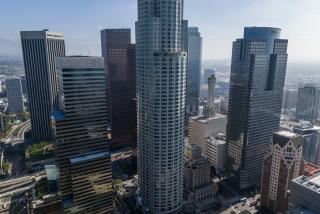Preservationists Score an Office Coup
One of Los Angeles’ most public landmarks has come to the rescue of one of the city’s most private ones.
A one-of-a-kind Modernist high-rise office designed by acclaimed architect John Lautner will be reassembled in the historic former May Co. building on Wilshire Boulevard’s Miracle Mile after being evicted from the 20th story of a Century City tower.
The Los Angeles County Museum of Art, which owns the 67-year-old Streamline Moderne building that was home to the former department store, will use the room -- built with walls of sleek copper and glass, a floor of triangular black slate and a ceiling of flowing wood -- as an executive office.
Preservation of the unusual office is a victory for devotees of modern architecture, who were horrified last fall when it was learned that the 850-square-foot room was scheduled to be demolished.
Real estate investor James F. Goldstein, a Lautner fan and owner of a Lautner-designed home in Beverly Hills, commissioned him to design the office in 1987. It was the only such space ever designed by the architect, who died seven years later.
But Goldstein lost his lease when a law firm in the building at 10100 Santa Monica Blvd. sought to acquire the entire 20th floor for its own use. Members of the John Lautner Foundation, a 10-year-old group that celebrates the architect’s legacy, tried without success to persuade the firm to preserve the space.
Goldstein, who spent about $500,000 on the interior design, moved out Sept. 30. A short time later, foundation members managed to delay demolition by persuading Los Angeles officials to designate the tiny office a city historic cultural landmark.
Then the foundation set out to find the office a new home.
Its first choice was the county art museum, but officials initially turned the foundation down, explaining that it had no exhibit gallery space large enough. Foundation leaders sought out alternative locations, including the Colburn School and the Museum of Contemporary Art in downtown Los Angeles and a museum in Palm Springs.
Last month, county art museum officials changed their minds. Director Michael Govan suggested installing the Lautner room in the museum-owned May Co. building as an office, not as artwork.
Melody Kanschat, the museum’s president and chief executive, said the 35-by-25-foot office will probably be reassembled on the fifth floor of the old department store, which the museum acquired in the early 1990s. Located at Wilshire Boulevard and Fairfax Avenue next to the museum’s main gallery, the building -- now called LACMA West -- is famous for its distinctive gold tower-like corner facade.
“The May Co. building is a city historic cultural landmark too. So it’s appropriate to put it there,” Kanschat said. “We’ll install it to use and to share. We could do evening or weekend tours, or use it for small lectures on art and architecture. It will be a working office as well as an art installation.”
Museum administrators hope to reassemble the Lautner office in 2008 or 2009, when work on the building’s upper floor is planned. The architect’s original design plans will be used for its reassembly.
That arrangement thrills foundation members.
“It’s hard to find the right home for such a unique space,” said foundation Vice President Christopher Carr, a Silver Lake architect who specializes in contemporary design. “The setting will still have windows facing the Hollywood Hills. Sunrises and sunsets will still reflect on the copper walls. People will still see what John Lautner was envisioning between nature and an office setting.”
Carr and foundation leader Duncan Nicholson, an architect who apprenticed with Lautner and took up the Modernist’s work upon his death, on Wednesday turned over 92 crates containing numbered, logged and carefully wrapped pieces of the office.
Museum officials blocked The Times’ attempt to photograph the unusual delivery.
Owners of the Century City high-rise paid the estimated $250,000 cost of disassembling and moving the office in an agreement with the foundation and the city. Under the room’s landmark designation, its demolition or removal could have been stalled for up to a year.
But the owners have sued Goldstein to recoup that cost, a move that has angered Lautner foundation leaders and left Goldstein “extremely surprised and outraged,” his lawyer, Thomas Casparian, said Friday. The high-rise owners could not be reached for comment.
The dismantling and the move went off without a hitch, however.
“Nothing got broken. It was amazing, considering all the glass and slate,” Carr said. “One piece of glass was 142 inches long and 27 inches wide.”
According to Carr, Goldstein -- who is out of the country and could not be reached for comment -- is pleased with the preservation plan. And so would Lautner be.
“You walk into that space, and you’re no longer in a box,” Carr said. “That office overtook your spirit. The longer you stayed in that room, the more you realized you were on this wonderful journey.”
A small space, he said, can make the spirit soar.
More to Read
The biggest entertainment stories
Get our big stories about Hollywood, film, television, music, arts, culture and more right in your inbox as soon as they publish.
You may occasionally receive promotional content from the Los Angeles Times.











